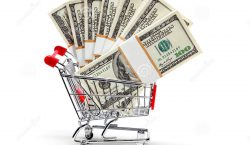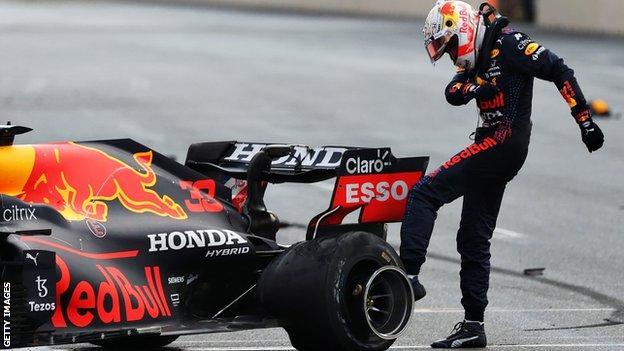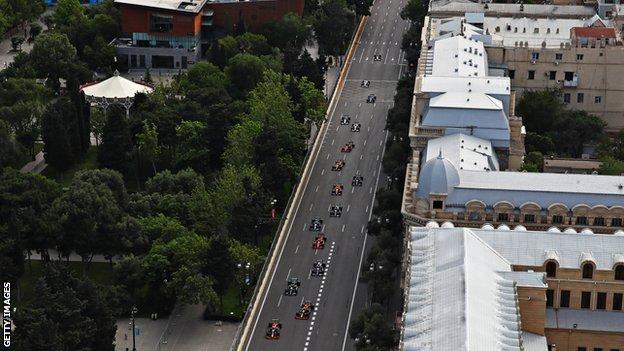

Stefano Domenicali has some good news he wants to share.
For four grands prix in a row now, the president of Formula 1 says, not a single person within the sport’s travelling community has tested positive for coronavirus.
The testing results, he says, are a vindication of F1’s carefully constructed Covid protocols, and a measure of its success in continuing to run a sport in which regular travel is unavoidable.
“It is proving that what we are doing is really something unique,” Domenicali says. “And if you consider the massive number of people involved in F1, it gives a sense of the dimension of the effort we are making to protect our business.
“We are proving that, despite the logistical complexities, we are moving around being safe, not creating any problems with the communities we are visiting, and guaranteeing the business we are involved in.”
The pandemic has made it a tough few months for Domenicali since the 56-year-old took on his new role at the start of the year. Races have been postponed and cancelled, others shuffled around, and that process is still ongoing.
But the battle with Covid is just one of a number of topics in the in-tray of the genial Italian, and in the course of his exclusive interview with BBC Sport from his office in central London Domenicali discusses:
F1 still reported one Covid case at each of the Portuguese, Spanish and Azerbaijan races, and four in Monaco, but the absence of cases among regular travelling personnel is an encouraging sign for Domenicali as he aims to run F1’s longest ever season – at 23 races – in the middle of the pandemic.
This number remains the target despite the postponement of the season-opening Australian Grand Prix, the cancellation of the races in Canada and Singapore, and doubts over several more.
So the obvious question – given last year’s season did not start until July and ran to 17 races when the original plan was for 22 – is why keep pushing for so many grands prix?
“I want to keep 23 because it has been promised,” Domenicali says. “It is a matter of showing the commitment to achieve what has been discussed.
“Saying that, I want to make sure we do 23 races provided the situation we are living with Covid will not create impossible constraints in which we cannot run.
“The right situation is complicated, but you can be sure I will not give up until the last moment.”
There are serious question marks over the grands prix in Japan, Mexico, Brazil and Australia, which account for much of the schedule in October and November. Options for replacements include races in Turkey and China, and a second at Austin in Texas, home of the US Grand Prix.
“It is not easy, but we have actions in place depending on how the situation evolves,” Domenicali says. “It would be easy to say we are ready to announce the Singapore substitute today, but what if Japan is not there? And Japan we will only know after the Olympics.
“With Australia, we will have some more news at the end of this month. So we are preparing different combinations, believing it is not easy but that it’s a beautiful challenge we have.”
When US giant Liberty Media took over the sport in 2017, its business model was to keep adding races to the calendar – the thinking being that more grands prix meant more income.
Domenicali’s predecessor Chase Carey made no secret of the fact that he was aiming for 25 races; in fact, the number is in the new contracts the teams signed committing themselves for the next five years.
Now, though, there has been a bit of a re-think. “Twenty-five is not at the moment the target on which I am preparing the business,” Domenicali says.
“We have so many requests from different places [to host races] because F1 is in great shape now, and I see from the enthusiasm around the world that there is no need to achieve that number.
“It is a matter of deciding where strategically we believe F1 should be developed, in which areas in which countries, and saying that the more opportunity we have, we want to be in certain places and not others. And the value of each country will be bigger.
“What is the right number of races? As soon as the pandemic has gone away, we need to understand what is the right balance between far east Asia, the Middle East and Africa, Europe and America. How many races can we have in each place?”
F1 is still convinced, though, of the need to shake up the format in a bid to add new, younger audiences while not alienating established fans, Domenicali says.
Hence the introduction this year at three events of ‘sprint qualifying’ – a shorter race on Saturday afternoons to decide the grid for the main grand prix. The first of these will be at the British Grand Prix next month.
If it proves popular and effective, Domenicali would like to expand the number of races run in a new way next year. The idea is to create a small number of events that can be, as he puts it, “highlighted or given more value”.
Floating the idea in a meeting with the drivers last weekend, Domenicali likened these events to tennis’ grand slams. But the new-format races would not be called that, he says; it was just a term he used to give a sense of “the idea of the project”.
But nothing is set in stone, not even how the races given this treatment would be chosen.
Perhaps F1 could highlight the historical races, he says, or the most popular ones, or the ones in a time zone that gives the biggest global audience.
“We have no rush. We don’t want to make a mistake. We have all of 2021 to make sure we do the right thing.”
He says F1 is open to ideas from all involved – including the fans.
“The intention is to find the best solution for everyone. No one has the magic bullet, or is presumptuous enough to [think they have] unique solutions. Any idea your readers can have, it would be great to know.”

Domenicali is a purist at heart. He is steeped in the sport. He was born and grew up in Imola, close to the famous circuit. He joined Ferrari after graduating from Bologna University and worked his way through the ranks to become team principal in 2007, succeeding Jean Todt, who is now president of the sport’s governing body, the FIA.
After resigning following the team’s poor start to the 2014 season, he was made head of special projects at Audi, and conducted a feasibility study on entry into F1 by the VW Audi Group. Ultimately the company decided against, although it is considering the idea again now.
He comes to his current role after five years as chief executive officer of Lamborghini.
With a CV like that, Domenicali has a deep knowledge and understanding of both the sporting and commercial sides of F1. And he is quick to defend Pirelli following the latest controversy over its tyres, underlining its importance to the sport, as a long-time partner and financial contributor.
He “can understand the frustration,” he says, of Max Verstappen, who lost victory in Baku last weekend when his left-rear tyre exploded and later said that he already knew Pirelli’s investigation would say that both his failure and that suffered by Aston Martin’s Lance Stroll were down to debris.
But Domenicali emphasises “the need to be respectful” of Pirelli, “be prudent and cautious” and wait for its conclusions.
He says: “There is a lot of trust in what Pirelli can do,” adding that he is confident the company will produce the more race-able, less thermally sensitive tyres F1 has commissioned for next year’s redesigned cars.
Pre-season, Domenicali organised a meeting with the drivers, at which he presented his thoughts on his new role. He urged them, he says, to discuss any concerns they had, over tyres or anything else, “in the proper place where if it’s correct we can discuss and find solutions” – ie, to be careful what they say in public.
“You know very well the magnitude of the wrong word in the wrong place,” Domenicali says. “That can be very difficult to recover and this is what we should avoid.
“We are running a business where we know drivers represent the most important voices and protagonists. [But] of course you may have the good friction and a good antagonistic discussion which is part of the game, which makes this business even more interesting.”

The 2022 rule changes, aimed at creating a more competitive field, are the first step into what Liberty hopes will be a future in which F1’s global appeal and audience increase. The next is new engines, to be introduced in 2025, which are part of F1’s plan to be carbon neutral by 2030.
The idea is to future-proof the sport in a world facing a climate crisis, but also to contribute to solving those issues.
The high-tech hybrid engines currently used in F1 are marvels of technology. They have a thermal efficiency – the measure of the conversion of fuel-energy to power – of more than 50%, when a standard road-car internal combustion engine is around 30%. As Domenicali puts it: “What we achieve today with our engine, no other engine on earth is achieving.”
But F1 has “not done very well” publicising this fact, he says, and must do better when the new engines are introduced.
F1 is in the process of deciding the technological detail of these new engines – Domenicali picks up two sheaths of documents from his desk to emphasise that it is being worked on as “a priority”. But the general plan is to increase the proportion of electrical energy and introduce fully sustainable fuels, while also keeping costs under control.
There is no contradiction, he says, between the road-car market heading rapidly towards electrification and F1 concentrating at least for now on hybrid.
“Despite everyone talking about electrification,” he says, “our dimension of hybridisation has a more significant role. Because if you look with a different perspective that is not the pure sporting one, billions of cars around the world today are using, let’s say, normal fuel.
“You cannot pretend to transform the world in the short term on sustainability without giving the chance to all the cars that are there to be still used for the next decades.
“And therefore the answer we are giving to the world with the help of the manufacturers is that, if we can follow sustainable fuels as an answer to sustainability, we are achieving an incredible mission.”
These net-zero carbon e-fuels, as they are known, are not just a potential greener alternative for internal combustion engines while the proportion of electric cars on the roads is still so low.
They could also be invaluable in areas where battery power will not be possible for years, because it lacks sufficient energy density. One key example is aviation, where a battery-powered airliner could not fly, because a battery with sufficient power to move it would be many times too heavy for the plane to be able to take off.
“The credibility comes from the fact that all the people working in this dimension are present in the discussions,” Domenicali says. “So we want to give a real answer to the needs of all the stakeholders that are part of this business.
“That’s why the time needed to find the right solution is not too short. We need to make sure that we can do that assessing all the different needs of the parties involved in the discussion.
“I can guarantee we are involving everyone in this topic in order to find the right solution for the future.” – bbc.com